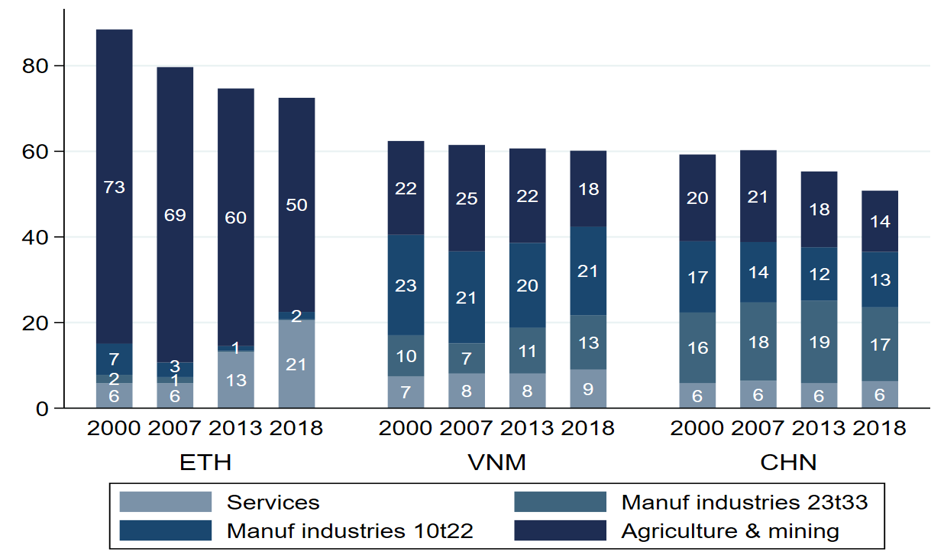 Activity content of exports has changed over time in three developing countries: Ethiopia, Vietnam, and China. Photo: © Curt Carnemark / World Bank
Activity content of exports has changed over time in three developing countries: Ethiopia, Vietnam, and China. Photo: © Curt Carnemark / World Bank
The question of what countries trade, and why, is a complex one, and it's important to understand that a country's comparative advantage doesn't always align with the types of products it exports. Comparative advantage refers to a country's relative efficiency in producing certain goods, based on factors like land, labor, capital, and technology. However, in today's globalized economy, production is often spread across multiple countries, which can make it difficult to determine what a country actually contributes to its exports.
Traditionally, research on trade has relied on gross export numbers to study what countries trade, and why. However, this approach can be misleading. If we just look at those numbers, we might conclude that countries like the Philippines have a strong comparative advantage in high-tech products like electronics. However, if we look at the value added in electronics exports, we will find that a substantial portion of the value added actually comes from the USA or Japan. This means that the Philippines' comparative advantage in electronics is lower than it might appear at first glance.
New wave of trade statistics offers deeper understanding of what countries do in their exports.
New research from the World Bank goes beyond traditional measures of value added and instead characterizes the specific activities involved in exports. By looking at things like engineering, management, support services, and production, we can gain a better understanding of a country's export profile. To get a comprehensive picture of how the activity content of exports has changed over time in different countries, we combine data on export income or job numbers in different industries and occupations with input-output data.
Figure 1 shows how the activity content of exports has changed over time in three developing countries: Ethiopia, Vietnam, and China (covering the years from 2000 to 2018). One interesting finding is that all three countries have shifted away from production activities like assembly and agriculture. China, in particular, stands out with half of its exports now falling under non-production activities, especially engineering. On the other hand, Ethiopia and Vietnam have maintained relatively high levels of exports in production activities throughout the period.
Figure 1. Activity content of exports, Ethiopia, Vietnam, and China by broad activity groups (% of export income)

Note: Percentage shares of activities in export incomes for Ethiopia (ETH), Vietnam (VNM) and China (CHN). Source: Kruse, H., Timmer, M.P., de Vries, G.J., Ye, X. (2023) Export Diversification from an Activity Perspective: An Exploration Using Occupation Data. World Bank Policy Research working paper no. 10463.
Next, take a closer look at the specific industries where production export activities are happening (see Figure 2). In Ethiopia, there has been a rapid expansion of production activities in the services sector, particularly in transportation, likely fueled by the increasing volume of export goods being transported through Addis Ababa's airport. In Vietnam, there has been a noticeable shift in production activities toward heavy manufacturing, which includes industries like electrical, machinery, and transport equipment. It has seen a significant increase, nearly doubling from 7 percent of export income in 2007 to 13 percent in 2018. On the other hand, China experienced a decline in exports of production activities after 2007, largely driven by decreases in agriculture and mining.
A recent study by Kruse et al. (2023) sheds light on how countries break away from their initial specialization in export activities and diversify their exports as they develop. The study looked at panel data from 59 countries and found that initially countries tend to shift to similar export activities in different industries. However, over time, these countries start diversifying the specific activities they perform within industries. This kind of diversification, where countries shift their activities within industries, is not easily detectable using traditional measures based on products or industries alone.
Figure 2. Production activity content of exports (%), Ethiopia, Vietnam, and China, by broad sector

Notes: Breakdown of production activities by industry in which production activity takes place: agriculture and mining refer to ISIC rev. 4 codes A and B, manufacturing industries to code C and services industries to codes D to U. Percentage shares of activities in export incomes for Ethiopia (ETH), Vietnam (VNM) and China (CHN). Source: Kruse, H., Timmer, M.P., de Vries, G.J., Ye, X. (2023) Export Diversification from an Activity Perspective: An Exploration Using Occupation Data. World Bank Policy Research working paper no. 10463.
These findings have important implications for policy decisions. Traditionally, policy makers have focused on analyzing exported products to shape their industrial policies. However, this approach may not provide a clear understanding of the actual capabilities needed for production. Instead, analyzing export activities can provide a more accurate picture of a country's export capabilities. This means that policy decisions that take into account the specific activities performed in exports can be more closely aligned with the real export capabilities required.
This study is part of a larger project called "Leveraging trade for more and better job opportunities in developing countries" which aims to gather valuable insights that can inform well-grounded policy implications for trade development and structural change. By delving into comprehensive data sets encompassing 5 activity groups, 20 sectors, and 59 countries spanning from 2000 to 2018, we aim to provide a solid foundation for deriving meaningful policy recommendations that can foster positive outcomes in terms of job opportunities and economic growth.






Join the Conversation